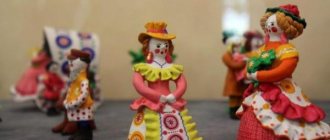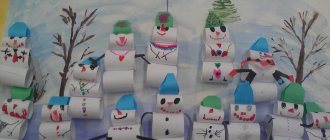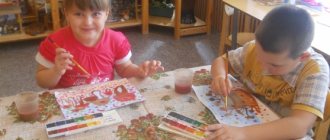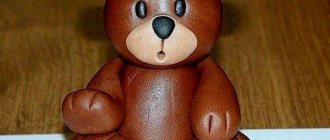Progress of the lesson:
Q. Guys, today a package was brought to our kindergarten, and there was an envelope inside.
Here's the package. Want to know what's in the envelope? Letter. The teacher reads the text.
Q. Guys, can we help the Dymkovo masters ? Let's see what else is in the envelope? Toy blanks .
Q. Look, there are several painted and unpainted toys . toys do you think these are ?
V. That's right, these are cockerels.
Q. Now you will paint toys with Dymkovo patterns , like real masters from the city of Dymkovo .
V. Let's remember the features of Dymkovo painting . What color is the main background of the toy ?
Q. Name the elements of Dymkovo painting that you know?
D. Rings, dots, circles, stripes, wavy lines...
Q. What colors are used to complete the painting?
D. Saturated, bright, colorful (children list colors)
.
Q. Guys, where will you start making your planned patterns?
D. First, large, large elements are drawn, and then small ones.
Q. Where will you place the largest element?
B. Correct. Guys, how are thin and small elements made?
B. Correct. To make a beautiful painting, we hold the brush vertically, near the iron skirt.
Q. Let me also remind you that patterns can be made using cotton swabs.
Q. Please tell me what other rules with a brush and paint do you know?
D. Moisten the brush and remove excess water on the edge of the jar or with a napkin. To mix paint, you need to use a palette. After each color of paint you need to rinse the brush. If the brush is not in use, place it on the stand. You cannot leave the brush in the jar. To prevent the paint from spreading, you should wait a little while the painted element dries .
V. And now, our masters, get to work!
B. The teacher individually gives advice on the selection of elements and colors (if the child has difficulty)
.
B. At the end of the work, the paint should dry.
- Which of you wants to talk about your toy ? (Ask 1-2 children)
.
— What pattern elements did you choose?
— What color are the patterns?
Q. Let's all take our works to the exhibition together and see what we've got.
V. All the work is good, you are great!
Notes on decorative drawing "Painting silhouettes of dishes based on Gzhel painting" in the senior group Notes on decorative drawing "Painting silhouettes of dishes based on Gzhel painting" in the senior group. Program content. GCD summary for decorative drawing in the senior group “Painting jugs with Khokhloma painting” GCD summary for decorative drawing in the senior group “Painting jugs with Khokhloma painting” Program content: Educational. Abstract of the GCD on decorative drawing in the senior group “Bookmark for books” Topic: “Bookmark for books” (based on Gorodets painting) Educational areas: artistic and aesthetic development, speech development,.
Abstract of a GCD for decorative drawing “A smart turkey” based on a Dymkovo toy A summary of a GCD for decorative drawing “A smart turkey” (based on a Dymkovo toy) Purpose: 1. To consolidate children’s knowledge about its characteristic features.
Abstract of GZhel in the middle-high group on decorative drawing “Gzhel motives” Objectives: to introduce children to Gzhel painting - the history of Gzhel and its origins, the variety of forms of Gzhel, the method of making handicrafts. Summary of GCD in the middle-high group for decorative drawing “Round Dance of Matryoshka Dolls” Objectives: to introduce children to the matryoshka doll as a type of folk toy - the history of creation, features of appearance and decor. Notes of NOOD in the senior group on decorative drawing “Decoration of a cutting board based on Gorodets painting” Notes of NOOD in the senior group on decorative drawing. “Decoration of a cutting board based on Gorodets painting.” Aleshina Elena Leonidovna.
Summary of the decorative drawing lesson “Festive fireworks” in the middle group Goal: creating a bright and expressive image of the festive fireworks. Objectives: teach children to select artistic techniques in accordance with.
Source
Preview:
Drawing lesson for the senior group.
“Decorative drawing based on Dymkovo painting.”
Educational areas: Artistic and aesthetic development.
Cognitive development. Speech development.
Type: Integrated organized joint educational
Specific types of children's activities:
Goal: To teach children to decorate the silhouettes of products with elements of Dymkovo
painting, choosing colors when creating a pattern. Generate interest
- Objectives: To develop children's creativity, sense of color, aesthetic sense, hand motor skills, the ability to highlight beautiful works, the ability to listen carefully to the teacher and answer questions.
- Continue to introduce children to folk arts and crafts (painting based on the Dymkovo toy). Strengthen children's ability to draw the simplest elements of Dymkovo painting (circles, stripes, wavy lines). Select paints (combination of colors so that the toy is bright and elegant). Practice drawing circles with continuous lines with the entire bristle of the brush, rings in one circular motion, drawing dots and dashes with the end brushes
- To cultivate neatness, aesthetic taste, love for Russian applied art, the desire to do something ourselves, adopting simple techniques from folk craftsmen. To cultivate respect for the work of folk craftsmen and admiration for their creativity.
- Learn on your own, create a pattern on a product of a new shape from familiar elements, place it near the frill in accordance with the shape of the skirt or dress.
- Story.
- Looking at albums and illustrations of Dymkovo toys.
- Conversation.
- Independent work.
- Physical education minute.
- Summing up (examining the drawings and describing them by children). Emphasize that they are bright, elegant, and varied. Induce a good mood from the work done.
Equipment and materials: Drawings of Dymkovo toys, pictures with elements of the Dymkovo pattern; samples of Dymkovo toys; watercolor paints, brushes, water, napkins, ready-made template drawings of the Dymkovo young lady, calm classical music.
Preliminary work: Teacher’s story, looking at albums, paintings about Dymkovo toys; conversations; clay modeling of Dymkovo toys; coloring coloring books, talking about the Dymkovo toy.
Educator: Today, children, I invite you to the gallery of drawings of the Dymkovo toy. Look how beautiful it is here! And how many different young ladies! Let's look at them. (Children independently examine toys painted in the style of Mist). They are all so bright, beautiful and very different. But they also have something in common! Guys, think and tell me what are the names of all these toys?
Educator: Why are they called that?
2. Main part.
“Far, far away, behind dense forests, behind green fields, on the banks of a blue river there stood a large village. Every morning people got up, lit the stoves, and blue smoke curled out of the chimneys of their houses. There were many houses in the village. So they called that village Dymkovo. Cheerful and mischievous people lived in that village. They loved to sculpt funny, bright, colorful toys and whistles. They will make a lot of them over the long winter. And when the golden spring sun rises in the sky, the snow runs away from the fields, cheerful people bring out their cheerful toys and let's whistle - drive away winter, glorify spring.
Funny toys were sold in different cities and villages. And after this name, the village and toys began to be called Dymkovo.
Educator: What color are Dymkovo toys?
Children: (Always only white).
Educator: What are the patterns on Dymkovo toys?
Children: (Straight line, wavy line, dot, circle, ring, cage, grid).
Educator: Which color is more? What colors are used?
— What techniques are used to make the patterns?
Children: (By dipping, the end of the brush, brush flat on the pile).
- Look at these young ladies: how are they similar to each other?
Children: (They all have wide dresses, skirts, aprons, beautifully decorated).
Educator: Correct! But these dresses remained white! They are offended and stand on the side. Let's help the young ladies and paint their dresses. Let them also stand proudly at this exhibition, and be glad that they, too, were decorated with beautiful colors. Try to make it bright and elegant. Don’t forget: we draw the lines with the tip of the brush, and apply patterns on the circles only after the circles have dried.
- Sit down more comfortably, let's start working.
During independent work, the teacher keeps all the children in sight, helps those who have difficulty creating a composition, monitors the landing, and the technique of performing the work.
After 10 minutes of independent work - a physical education minute.
We tried to draw (arms to the sides)
It was difficult not to get tired (torso bends to the sides)
We'll rest a little (sit down, hands forward)
Let's start drawing again (stand up, put your hands down)
- Now finish your work, finish drawing the patterns, and then we’ll see your drawings.
To summarize, the teacher hangs up all the drawings, offers to choose the most elegant young ladies and answer the questions:
- What job did you like best? Why?
- What did you like most here?
- What's special about this job?
- How is this job different from others?
Well done, everyone tried to create new beautiful Dymkovo patterns. The lesson is over.
Groups: Shadrina N.V.
On the topic: methodological developments, presentations and notes
Strengthen the skills of drawing elements of Dymkovo painting (circles, dots, stripes, grid, ring, wavy arcs).
Educational field “Fine arts” Program objectives: - give the concept of “decorative and applied arts”; continue to introduce the folk crafts of Gzhel; zak.
Drawing lesson in the senior group “Decorative drawing based on Dymkovo painting.”
Notes on drawing.
Objectives: Educational - To consolidate children’s knowledge about the basic means of expressiveness of the Dymkovo toy: brightness, elegant colors, decorativeness, variety of painting elements; - order.
Decorative drawing based on the fairy tale “Ryaba Hen (based on Dymkovo painting)” Purpose: To consolidate children’s knowledge about Dymkovo painting, developing the ability to create patterns on their own.
Abstract of OOD on drawing in the senior group “Decorative drawing. Gorodets painting of a wooden board.”






